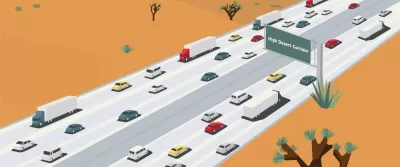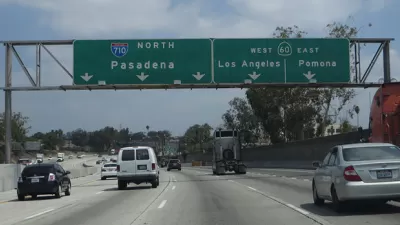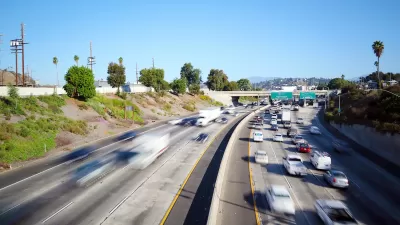What could have been the first new freeway for Los Angeles County in decades might now only mark the end of an era.

"A recent court settlement spells the end for the planned High Desert Corridor Freeway," reports Joe Linton from Southern California.
The High Desert Corridor would have been an $8 billion, 63-mile freeway spanning two counties—Los Angeles and San Bernardino. "In 2016, Caltrans certified the project’s Environmental Impact Report (EIR). The plan was for a High Desert 'multi-purpose corridor' featuring an 8-10 lane freeway, plus bike path, solar panels, and high-speed rail," according to Linton. The project was also lined up for nearly $2 billion in funding from Measure M, the L.A. County transportation sales tax approved by voters in 2016.
As explained by Linton, the project's EIR provoked a lawsuit from environmental groups, challenging the project on terms set by both state and federal environmental regulations. A judge sided with the plaintiffs, finding that the EIR was insufficient in measuring biological and greenhouse gas impacts. Instead of drafting a supplemental EIR, Caltrans has decided to shelve the project, reports Linton.
Frontier Group and U.S. PIRG earlier this year named the project as one of the nation's worst highway boondoggles, and now that the project is dead, the Los Angeles Times Editorial Board has taken a firm stance in opposition to the idea. The editorial raises one salient question that continues to plague land use and transportation planners in the state of California: Why is a state committed to reducing emissions and continuing to allow so much development in far-flung, exurban communities? The Trump administration has even begun to exploit the state's hypocrisy.
FULL STORY: Caltrans Settles Environment Lawsuit, Cancels High Desert Freeway Project

Maui's Vacation Rental Debate Turns Ugly
Verbal attacks, misinformation campaigns and fistfights plague a high-stakes debate to convert thousands of vacation rentals into long-term housing.

Planetizen Federal Action Tracker
A weekly monitor of how Trump’s orders and actions are impacting planners and planning in America.

In Urban Planning, AI Prompting Could be the New Design Thinking
Creativity has long been key to great urban design. What if we see AI as our new creative partner?

King County Supportive Housing Program Offers Hope for Unhoused Residents
The county is taking a ‘Housing First’ approach that prioritizes getting people into housing, then offering wraparound supportive services.

Researchers Use AI to Get Clearer Picture of US Housing
Analysts are using artificial intelligence to supercharge their research by allowing them to comb through data faster. Though these AI tools can be error prone, they save time and housing researchers are optimistic about the future.

Making Shared Micromobility More Inclusive
Cities and shared mobility system operators can do more to include people with disabilities in planning and operations, per a new report.
Urban Design for Planners 1: Software Tools
This six-course series explores essential urban design concepts using open source software and equips planners with the tools they need to participate fully in the urban design process.
Planning for Universal Design
Learn the tools for implementing Universal Design in planning regulations.
planning NEXT
Appalachian Highlands Housing Partners
Mpact (founded as Rail~Volution)
City of Camden Redevelopment Agency
City of Astoria
City of Portland
City of Laramie





























